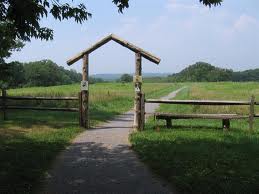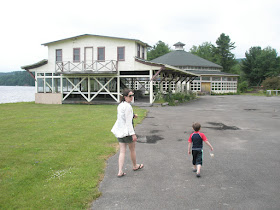View from the village toward Amtrak and the Hudson
At
some point in the 1800s – no one seems to know when – a unique fishing
community sprang up along the river in Hudson, NY. And as of today, that unique community will
exist no more. It will go the way of other communities of free spirits in this
region, like the fiercely independent Taghanic Basketmakers who were driven
out of the hills above Lake Taghanic 90
years ago.
Entrance to Furgary is next to Hudson's waste treatment plant
Known
as the Furgary Boat Club – and no one seems to known the origin of the word –
generations of local people have made use of the collection of shacks between
the town’s waste treatment plant and the Hudson River. For years, city officials have talked about
evicting the Furgary squatters but now that threat has finally become a
reality.
Contemplating the end of an era
Two
days before the eviction, I visited the site and talked with a melancholy group of Furgary folk. Most, if not all, had memories of the place
going back to childhood and none could really understand why the City of Hudson
was taking away land they had long regarded as their own. But the problem is that the land was never their
own in any legal sense. Joe Gallo, the president of their official group, the
North Dock Tin Boat Association, told WGXC
that there were never any deeds for the shacks nor any legal
means of transfer. Informal arrangements
and mutual trust among members were what held the little community together.
And according to a Register-Star article,
no one ever lived there full-time. (I found no real evidence, one way or the
other, on this claim.)
Longtime Furgarians
When
I visited, the community residents were friendly enough but I was told by other
local people that the Furgarians had long regarded the area as their private
property and had posted plenty of No Trespassing signs prior to their recent
troubles with the City. Apparently,
membership was usually limited to people whose families had lived in Hudson for
generations. However, one man who had moved
to Hudson only a decade ago told me that he was friendly with the villagers and
was considered a welcome guest by them whenever
he dropped by. But in no sense did the fishermen ever consider it public land,
although in fact the several acres of shoreline and wetland do belong to the
City of Hudson.
Wetlands stretch north from the Furgary shacks
The
long-simmering dispute over ownership of the fishing village was brought to a
head three years ago:
“In
August of 2009, while performing a deed search, the Columbia Land Conservancy discovered the land, and the adjacent waste water
treatment plant property, belonged to the state, which promptly traded it for
property under the river owned by the city. Now that Hudson knows they own the
land officials see development potential for the riverfront property.”
"Main Street"
Although Hudson’s current mayor, William Hallenbeck, said in a Common Council meeting on
July 9 that he wished he could find a way to save the Furgary camp, the fisher
folk with whom I spoke doubted his sincerity.
Their leader Joe Gallo, said that former mayor Rick Scalera was so adamant
to destroy the community that he would be driving the first bulldozer.
According to Gallo, the City has failed to recognize the services provided
gratis by the Furgarians, for which the City would now have to pay:
“For a century and a half, we have been stewards of this part of
the Hudson River. We have not only worked the river for shad and other fish,
we’ve also managed the habitats and public hunting grounds of the foreshore,
North Bay and Middle Ground Flats. We’ve safeguarded this area for the many
children and pets who are drawn to it. And we’ve done it for free.”
Whether the
destruction of this community will be cost-effective for the City of Hudson
remains to be seen but it is clear that, as Gallo says, the City has shown “No
regard for the cultural aspect.” This kind of American community outside the
usual restrictions of laws and deeds was once common, but now is extremely rare. As one
fisherman-hunter-trapper told me, “Since Katrina, there’s nothing like us this
side of the Mississippi.” Surely, a
wiser as well as more economically sound course might be to preserve the unique
community but open it to a wider public.
Issues of liability cited by City officials could certainly be handled
much the same as for other city parks.
Moving Day
No one with whom I
spoke has any real idea of what will follow the destruction of the Furgary
community. A strong possibility is that the Columbia Land Conservancy, whose researcher
discovered the title discrepancy that set this whole
crisis in motion, may seek to extend its adjacent natural area north of the
city. The organization’s Summer 2012 newsletter includes an article entitled “A Transformational Plan for Hudson’s
Waterfront.”
Although no mention is made of
the Furgary site, the accompanying map illustrates a plan “to connect the heart
of Hudson to the Greenport Conservation Area and beyond.” And a non-profit like the CLC certainly has a
number of donors and supporters with deep pockets who could well have an
influence on local officials. There are
also rumors of condo development, but considering that the site is right next
to the city Waste Treatment Plant, that seems highly unlikely.
The CLC's Greenport Conservation Area adjoins Furgary site
I suspect that the most likely
impetus behind the community’s destruction is the drive by a well-funded non-profit
(i.e. the Columbia Land Conservancy) to keep expanding protected areas in the
county. While such a motive is, in general, to be applauded, in this case it
may well be that the “green” values of some of the county’s more influential residents
are prevailing over the age-old traditions of a small group of local people.
Update July 19, 2012
We visited the Furgary site a few days after the Hudson PD’s SWAT team launched its 3 a.m. assault against what amounted to “three grumpy old men. ” The little cove was quiet and deserted, except for a few hungry cats. Police had strung netting loosely around the property and tacked up a few unofficial No Trespassing signs, but clearly no one was attempting to reoccupy the site – which raised the question of why Hudson authorities felt the need for such overwhelming force to back up its eviction orders.
The Register-Star reported that the Hudson Police Department felt the need for a SWAT team because of reports that people on the site were armed and planning to reist the eviction. No word on where such rumors originated. Mayor Hallenbeck also tried to justify the SWAT option in an interview with WGXC radio. A well-informed older gentleman who joined me while I was looking over the now closed little village blamed the overreaction on the excessive dumping of military equipment into America's police forces by the feds after 9-11.



























.JPG)

